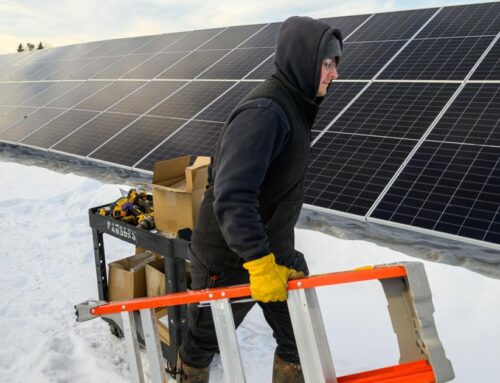Interview: Gender equality is key to a just renewable energy future | UN Women
April 21, 2025
Energy powers every aspect of our lives, and by 2050, up to 90 per cent of the world’s electricity could come from renewable sources. This shift could dramatically reduce greenhouse gas emissions and help us avoid the worst consequences of climate change. But one thing is clear: we can’t achieve this future without women.
Currently, women make up just 32 per cent of the renewable energy workforce – a significant gap and a missed opportunity for climate action and a truly just energy transition.
UN Women spoke with Sanjana Chhantyal from Nepal, a youth advocate and member of the Asia Pacific’s 30 for 2030 leadership network, about what it will take to centre women in the renewable energy sector – and why financial inclusion must be part of the solution.
How an indigenous woman from Nepal is powering change
“Being a girl from an indigenous community in Nepal, I had limited access to opportunities, networks and information,” says Sanjana Chhantyal. “It took a lot of initiative to do my own research, access higher education, and not let my circumstances limit what I could achieve.”
That decision – to take control of her own future – was her first act of activism.
“I’ve always wanted to help open doors for other young girls whose dreams are bigger than their circumstances,” she says.
Chhantyal saw firsthand the information barriers that hold girls back in marginalized communities. She created a toolkit to help them access higher education and personally mentored students. Later, as a Fulbright scholar, she co-founded a “women in energy” project to prepare young women in Nepal for careers in the renewable energy sector.
Breaking myths: Women belong in the energy sector
“There’s a misconception that the energy sector is only for engineers,” says Chhantyal. “That’s harmful, because there are fewer women in engineering – so they’re even less likely to see themselves in energy.”
Her project – launched with fellow Fulbright scholars and funded by the Alumni Engagement Innovation Fund – deliberately focused on highlighting the importance of interdisciplinary skills for clean energy. It showed how careers in law, environmental policy, business, labor rights, and finance intersect with the renewable energy sector, beyond engineering. “No single skill set can carry the sector alone. It will thrive when people with diverse skills come together with a shared purpose.”
They targeted women finishing undergraduate and postgraduate programmes – many of whom had no idea how to enter the field – with the goal of providing training and inspiring women to see themselves in the renewable energy sector.
The project also emphasized entrepreneurship. “Entrepreneurship isn’t encouraged among women in many communities,” says Chhantyal. But green business is a powerful way to involve more women in energy, especially given the gender gap in STEM.
Financial access for women: The missing piece in a gender-equal energy transition
Chhantyal is clear: none of this is possible without financial inclusion. “Financial instruments and products are simply not designed for women,” she says. “They don’t reflect women’s realities.”
Take collateral requirements for loans. Many women don’t own land or assets. Or consider the burden of documentation – often difficult for women in informal work, especially when financial institutions lack inclusive support services.
“If financial products are meant to serve women, they must be designed to eliminate the barriers women face,” says Chhantyal.
Addressing gender-based violence in financial systems
Chhantyal also highlights a critical, often overlooked issue: safety.
“Preventing and addressing gender-based violence must be part of financial design,” she says. Accessing financial services is not always safe for women, with some facing exploitation and demands for sexual favors. “Accountability and transparency are critical in creating inclusive financial ecosystems. There must be mechanisms in place so women can report abuse and get help.”
Financial institutions don’t have to address these challenges alone – they can collaborate with civil society organizations to co-create solutions, she adds. “Financial institutions have financial capital and civil society organizations have social capital. More should be done to combine them.”
Chhantyal calls for gender-responsive financing that values women’s ideas and lived experiences, supports their intellectual property, and works for women in the informal economy.
Why women hold the key to a sustainable energy future
Globally, women and girls bear the brunt of energy poverty. They are also the main providers and managers of household energy, and active agents in this sector. When they lack access to energy, their unpaid care work increases, as well as health and safety risks. Indoor air pollution from using combustible fuels killed 3.2 million people in 2020 – most of them women and children.
Universal access to electricity could lift 185 million women out of poverty by 2050.
For Chhantyal, women’s lived experiences, creativity, and leadership are essential to building renewable energy solutions that work – for people and the planet.
Related content
For All Women and Girls: Pendo Vestine on closing the gender gap for girls in tech
3 April 2025
For All Women and Girls: Pendo Vestine on closing the gender gap for girls in tech
Speech: The Political Declaration’s vision must be made real – Change is there now to be grasped
21 March 2025
Speech: The Political Declaration’s vision must be made real – Change is there now to be grasped
Young feminist leadership at CSW69: Mobilizing a generation for gender equality, 30 years after the Beijing Platform for Action
18 March 2025
Search
RECENT PRESS RELEASES
Strategy Inc (MSTR) Stock Drops After $980M Bitcoin Buy: SEC Filing Details, Nasdaq 100 Im
SWI Editorial Staff2025-12-15T14:14:40-08:00December 15, 2025|
Bitcoin drops under $86K as $2.78B in BTC whale selling overwhelms active dip buyers
SWI Editorial Staff2025-12-15T14:14:25-08:00December 15, 2025|
MetaMask rolls out Bitcoin support, continuing multi-chain expansion
SWI Editorial Staff2025-12-15T14:14:07-08:00December 15, 2025|
Bitcoin extends 2025 losses as silver, gold, & copper surge
SWI Editorial Staff2025-12-15T14:13:50-08:00December 15, 2025|
Look Out Below: Another 3% Drop In Bitcoin Brings This Token Toward a Key Level
SWI Editorial Staff2025-12-15T14:13:33-08:00December 15, 2025|
Why are BTC, XRP, ETH and SOL down today and what’s next
SWI Editorial Staff2025-12-15T14:13:17-08:00December 15, 2025|
Related Post



